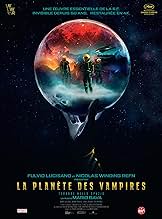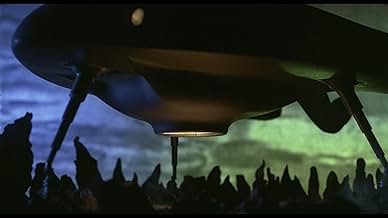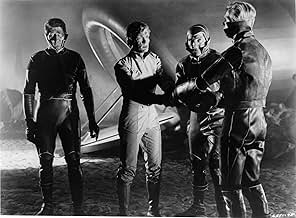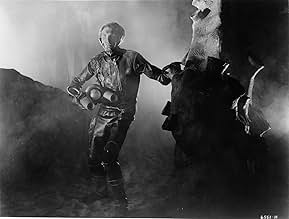IMDb रेटिंग
6.2/10
7.7 हज़ार
आपकी रेटिंग
अपनी भाषा में प्लॉट जोड़ेंAfter landing on a mysterious planet, a team of astronauts begin to turn on each other, swayed by the uncertain influence of the planet and its strange inhabitants.After landing on a mysterious planet, a team of astronauts begin to turn on each other, swayed by the uncertain influence of the planet and its strange inhabitants.After landing on a mysterious planet, a team of astronauts begin to turn on each other, swayed by the uncertain influence of the planet and its strange inhabitants.
- पुरस्कार
- कुल 1 नामांकन
Ángel Aranda
- Wess Wescant
- (as Angel Aranda)
Federico Boido
- Keir
- (as Rico Boido)
Vito Fasano
- Dead Galliott Crew Member
- (बिना क्रेडिट के)
Giuseppe Mattei
- Brent
- (बिना क्रेडिट के)
फ़ीचर्ड समीक्षाएं
Mario Bava does it again. The crystal colours, eerie atmosphere and evocative visuals are downright dazzling and haunting in this low-budget Italian Sci-fi outing. Never have I been disappointed in these technical aspects while experiencing the master at work. Many have mentioned it and the influences / similarities to Ridley Scott's 'Alien (1979)' ultimately sticks out. Even with that in mind it does share some ideas with the body snatcher theme, but it was a cleverly done concept done in a slow grinding, but extremely engaging style. The pacing is slow, but the flashy imagery and smoothly placed camera-work was hypnotic that it helped time flow by. My only real gripe was that the script was on the stilted side, but other than that it was one of those subtlety breezy mood pieces. More often the deaths happen off-screen and it's mostly free of action, to really only hit in the dying stages in some rapid set-pieces, but it's the dreary ending that's a strike of genius. Bava's crisp direction lets the otherworldly Gothic vibe take hold and while the sterile set designs look cheap it manages to be effective in its unusually stylish looks (add in seeping fog) and this invokes brooding unease and alienation. The surrounding sound effects and music score are creepily orchestrated. As for the special effects/make-up FX for such a low-cost production, they were well executed and ideally used. The acting can be rather rough in a staged sense with a dependable Barry Sullivan heading the way. Some of the characters were hard to tell apart though. A marvellously old-fashion, but influentially chilling space expedition.
The spaceships Argos commanded by Captain Mark Markary (Barry Sullivan) and her sister Galliot commanded by Captain Sallas (Massimo Righi) travel to the mysterious planet Aura to investigate a strange transmission of a distress signal. The spaceships are protected by the meteor rejector instrument but on the arrival, the gravity increases and the automatic controls go haywire and the Galliot crashes on the surface of Aura. Then the crew-members in Argos go crazy and attack each other in a first moment. Soon Captain Mark finds that most of the crew from Argos is dead after fighting against each other. When the dead members resurrect, Captain Mark, communications officer Sanya (Norma Bengell) and engineer Wess (Ángel Aranda) discover that parasite bodiless aliens have entrapped them with the transmission expecting to flee from their dying world. What will be their attitude?
"Terrore nello spazio", a.k.a. "Planet of the Vampires", despite the low- budget, is an original, stylish and with a surprising plot point. The conclusion shows a great surprise to the viewer. This movie was certainly the major influence to at least Ridley Scott's "Alien" and "Prometheus" that have similar storyline. It was said that the set was a Tower of Babel, with international cast using their own native language (Barry Sullivan, English; Norma Bengell, Portuguese; Ángel Aranda, Spanish; and Evi Marandi, English). My vote is seven.
Title (Brazil): "O Planeta dos Vampiros" ("The Planet of the Vampires")
"Terrore nello spazio", a.k.a. "Planet of the Vampires", despite the low- budget, is an original, stylish and with a surprising plot point. The conclusion shows a great surprise to the viewer. This movie was certainly the major influence to at least Ridley Scott's "Alien" and "Prometheus" that have similar storyline. It was said that the set was a Tower of Babel, with international cast using their own native language (Barry Sullivan, English; Norma Bengell, Portuguese; Ángel Aranda, Spanish; and Evi Marandi, English). My vote is seven.
Title (Brazil): "O Planeta dos Vampiros" ("The Planet of the Vampires")
This new release in the "MGM Midnight Movies" series of DVDs is an absolute must-have. The print of this 1965 classic is gorgeous, and for the first time since its theatrical release viewers can see the film in its original wide-screen format. For those who -- like me -- purchased the HBO Video version on VHS, don't worry: The original spare-but-effective electronic score has been restored, instead of the "updated" abomination that made the VHS print almost unwatchable.
Although I've never heard Dan O'Bannon acknowledge it, certain elements of this film must have been in his mind when he was working on "Alien": Two spaceships are drawn to an eerie, fog-shrouded planet by a mysterious radio signal, then snatched from orbit by an irresistible force. After crash landing, the surviving crew find themselves pitted against their own dead shipmates, resurrected by the parasitic mentalities of the planet, a dying race who must find a new home. There's even a scene where Barry Sullivan and Norma Bengell investigate an ancient, derelict alien spacecraft, complete with giant skeletons (any of this sound familiar?)
The set designs -- the cavernous interior of the spaceship and the appropriately alien fixtures of the derelict -- are some of the best you'll find in any pre-1968 science fiction film. Sullivan is suitably stoic as the warrior-scientist Captain; the supporting cast and in particular the luscious Ms. Bengell turn in remarkably understated performances, perfectly conveying dread verging on panic. While this movie may disappoint fans of director Mario Bava who are more familiar with his horror films, as a science fiction film buff I rate it a solid 7.
Although I've never heard Dan O'Bannon acknowledge it, certain elements of this film must have been in his mind when he was working on "Alien": Two spaceships are drawn to an eerie, fog-shrouded planet by a mysterious radio signal, then snatched from orbit by an irresistible force. After crash landing, the surviving crew find themselves pitted against their own dead shipmates, resurrected by the parasitic mentalities of the planet, a dying race who must find a new home. There's even a scene where Barry Sullivan and Norma Bengell investigate an ancient, derelict alien spacecraft, complete with giant skeletons (any of this sound familiar?)
The set designs -- the cavernous interior of the spaceship and the appropriately alien fixtures of the derelict -- are some of the best you'll find in any pre-1968 science fiction film. Sullivan is suitably stoic as the warrior-scientist Captain; the supporting cast and in particular the luscious Ms. Bengell turn in remarkably understated performances, perfectly conveying dread verging on panic. While this movie may disappoint fans of director Mario Bava who are more familiar with his horror films, as a science fiction film buff I rate it a solid 7.
Mario Bava's Planet of the Vampires is one of the films credited as being a major influence on Ridley Scott's Alien (1979), and it's easy to see why: there are numerous scenes and elements that are very similar to those in Scott's movie (albeit with a distinct '60s Euro sci-fi flavour). Bava's movie isn't on a par with Alien in terms of overall quality-the movie suffers a little from its low budget and it treads water for a long while-but its sense of style and originality still makes it a lot of fun for those who enjoy retro sci-fi/horror.
The film starts as the crew of the spaceship Argos (a horseshoe shaped craft, much like the alien spaceship in Alien) approach the planet Aura having receiving a strange transmission (as in Alien). They land on the foggy surface of the planet (as in Alien) and are immediately gripped by a compulsion to attack each other. After this spate of craziness passes, the crew walk to their sister ship, the Galliot, which also landed on the planet, and find the crew dead. Further investigation of the surrounding area reveals the wreck of an alien ship (as in Alien) where they discover the giant skeletons of its extraterrestrial crew (as in Alien). Eventually, it transpires that the space signal intercepted by the Argos was sent by a dying race that seeks to inhabit any visitors unfortunate to land on their planet (parasitic creatures - Alien anyone?).
For all of their similarities, Bava's film couldn't be much more different to Alien in terms of style: whereas Scott's film aimed for a gritty sense of realism, Bava's is much more rooted in pulp sci-fi comics, with the strangely spacious spaceship Argus, its crew's snazzy uniforms (the collars and hoods are hilarious), lots of high tech equipment with flashing diodes, a bright colour palette, and strong use of light and shadow. The film also predates George Romero's Night of the Living Dead with the reanimated crew of the Galliot more akin to modern day zombies than vampires.
After quite a bit of filler, the surviving members of the Argus finally escape Aura, the film ending with a twist worthy of an episode of Rod Serling's The Twilight Zone.
6.5 out of 10, rounded up to 7 for the tasty female crew members of the Argus, sexy redhead Sanya (Norma Bengell) and blonde hottie Tiona (Evi Marandi).
The film starts as the crew of the spaceship Argos (a horseshoe shaped craft, much like the alien spaceship in Alien) approach the planet Aura having receiving a strange transmission (as in Alien). They land on the foggy surface of the planet (as in Alien) and are immediately gripped by a compulsion to attack each other. After this spate of craziness passes, the crew walk to their sister ship, the Galliot, which also landed on the planet, and find the crew dead. Further investigation of the surrounding area reveals the wreck of an alien ship (as in Alien) where they discover the giant skeletons of its extraterrestrial crew (as in Alien). Eventually, it transpires that the space signal intercepted by the Argos was sent by a dying race that seeks to inhabit any visitors unfortunate to land on their planet (parasitic creatures - Alien anyone?).
For all of their similarities, Bava's film couldn't be much more different to Alien in terms of style: whereas Scott's film aimed for a gritty sense of realism, Bava's is much more rooted in pulp sci-fi comics, with the strangely spacious spaceship Argus, its crew's snazzy uniforms (the collars and hoods are hilarious), lots of high tech equipment with flashing diodes, a bright colour palette, and strong use of light and shadow. The film also predates George Romero's Night of the Living Dead with the reanimated crew of the Galliot more akin to modern day zombies than vampires.
After quite a bit of filler, the surviving members of the Argus finally escape Aura, the film ending with a twist worthy of an episode of Rod Serling's The Twilight Zone.
6.5 out of 10, rounded up to 7 for the tasty female crew members of the Argus, sexy redhead Sanya (Norma Bengell) and blonde hottie Tiona (Evi Marandi).
23 May 2008. Fourteen years after "The Planet of Vampires" (aka Demon Planet), Ridley Scott would create one of the most frightening and densely layered science fiction/horror films in history that he titled, "Alien." The strong suggestive set design and atmospheric elements from "The Planet of the Vampires" would re-appear in "Alien." Script plots from the original Star Trek television series that began its run in 1966, two years before, are nicely incorporated into this serious attempt at science fiction/horror. While obviously outdated by time, the eerie, alien sounds and visual designs are outstanding for its time. Overall, this movie stands the test of time for its power, its emotional, visceral impact on the senses and its delivery. Eight out of Ten Stars.
क्या आपको पता है
- ट्रिवियाThis film marks the first collaboration between Mario Bava and his son/assistant director Lamberto Bava. Lamberto would later become a director himself.
- गूफ़When Toby and Mark duke it out, Toby bumps into and moves the flight seat revealing it to be unattached to the deck.
- भाव
Capt. Mark Markary: I'll tell you this, if there 'are' any intelligent creatures on this planet... they're our enemies.
- इसके अलावा अन्य वर्जनThe original Italian version runs 88 minutes long. The US version runs 86 minutes long.
- कनेक्शनFeatured in Aweful Movies with Deadly Earnest: The Demon Planet (1969)
टॉप पसंद
रेटिंग देने के लिए साइन-इन करें और वैयक्तिकृत सुझावों के लिए वॉचलिस्ट करें
- How long is Planet of the Vampires?Alexa द्वारा संचालित
- Is 'Planet of the Vampires' based on a book?
- What language are they speaking?
- How does the movie end?
विवरण
- रिलीज़ की तारीख़
- कंट्री ऑफ़ ओरिजिन
- भाषाएं
- इस रूप में भी जाना जाता है
- Demon Planet
- फ़िल्माने की जगहें
- उत्पादन कंपनियां
- IMDbPro पर और कंपनी क्रेडिट देखें
बॉक्स ऑफ़िस
- बजट
- $2,00,000(अनुमानित)
- चलने की अवधि1 घंटा 28 मिनट
- ध्वनि मिश्रण
- पक्ष अनुपात
- 1.66 : 1
इस पेज में योगदान दें
किसी बदलाव का सुझाव दें या अनुपलब्ध कॉन्टेंट जोड़ें





























